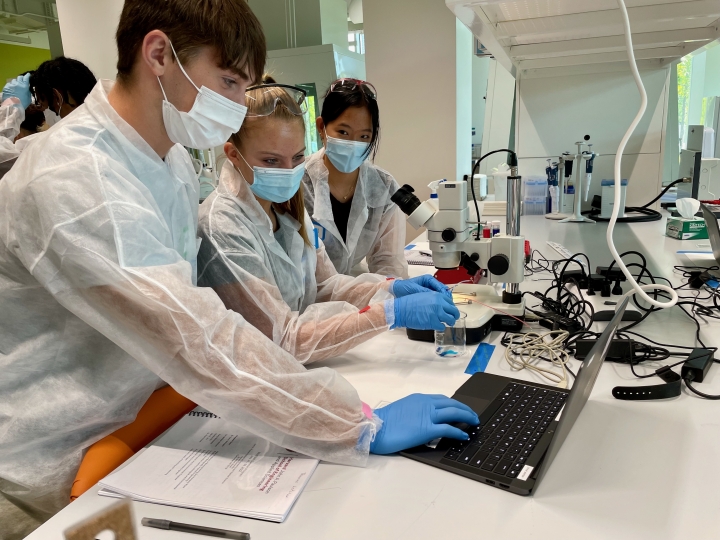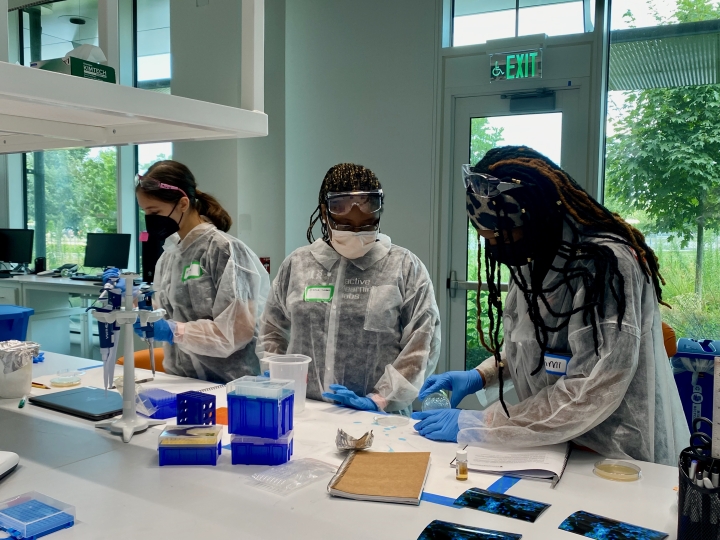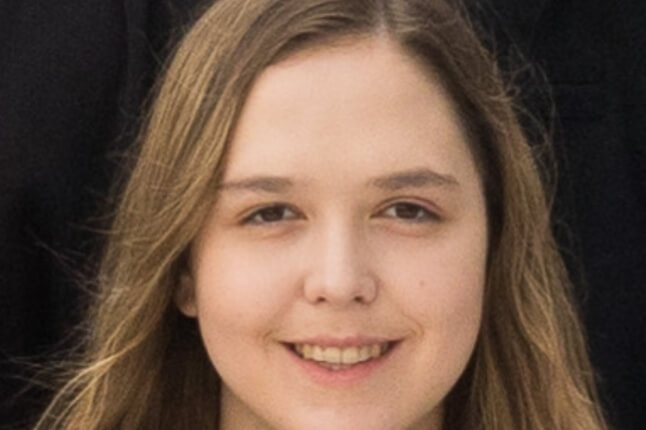News
Thomas Allen Letcher (Westlake High School), Lana Gibbs (Brooks School) and Bori Kim (Andover High School) observe laminar flow on the microfluidic device they fabricated in the Active Learning Labs.
Many high school students may learn about cutting-edge biological tools as part of their core curriculum, but few have the opportunity to experience those concepts hands-on. The summer 2022 BioSTAR Program, hosted in the Active Learning Labs (ALL) at SEAS, provided just that.
As part of BioSTAR (short for Bioengineering Science, Technology, and Research), a cohort of 16 Boston-area students ventured to Harvard’s campus for a deep dive into experimentation in the biological sciences. Participants joined from Cambridge, Mattapan, Roslindale, East Boston, and more, representing a range of public, private, and charter schools. Under the faculty mentorship of Professor Samir Mitragotri and led by ALL team members Melissa Hancock, Avery Normandin, and Caroline Ko, the program was designed to give young learners practical experience in engineering education in Harvard’s laboratory spaces, as well as the opportunity to engage directly with SEAS faculty and researchers. There is also a wintersession version of BioSTAR for first- and second-year undergraduates interested in pursuing bioengineering.
Since this was nearly everyone’s first experience in the lab, participants first had to develop an experimental toolkit. The first two days focused on building foundational laboratory skills including pipetting, working in a sterile tissue culture hood, and performing different types of microscopy.
The remaining five days, after which students grew confident in their experimental skills, were devoted to performing lab exercises in collaborative small groups. They explored culturing mammalian cancer cells; labeling cells with fluorescent markers and imaging them on digital microscopes; fabricating and testing biocompatible microfluidic devices; and even synthesizing drug nanoparticles. The program’s culminating experiment: growing cells in three-dimension culture and treating them with an anti-cancer drug.
Aimi Nosa-Uwiafo (Brooke High School), Bianca Lobban (Edward Brooke High School) and Maxine Kamen van Westen (Arlington High School) plate E. coli as part of their CRISPR-Cas9 gene editing experiment.
Most of the topics they encountered are part of the undergraduate curriculum for SEAS bioengineering students, giving the students a glimpse into what it’s like to study bioengineering in an academic context. “I really enjoyed the ability to experience how it feels to work in a lab to find an answer for our experiments,” one participant said in an anonymous survey. “Being able to learn more about cancer treatments and getting an idea of how people go about this research made me think more deeply about what cancer is and how it works.”
BioSTAR participants also learned common techniques in molecular biology and microbiology in a module focused on gene editing. They performed an experiment that involved using CRISPR-Cas9 genome editing technology to deactivate gene expression in E. coli. In addition to their hands-on work, the students were also asked to think about theoretical applications of CRISPR-Cas9 in the context of cancer biology. They brainstormed potential projects ranging from T cell engineering to using viral vectors to deliver CRISPR systems targeting cancer-causing genes.
On the final day of the program, students presented highlights of their experimental journeys to their families as well as the broader SEAS community. They also shared their reflections on these early experiences in the lab setting: “One thing I learned about bioengineering as part of BioSTAR was how many ways we can use biology to understand different things about ourselves.Something that excited me was the possibilities that come with the tools that we have at our disposal to be able to create and research new things,” one participant noted. Students completed the program with confidence to pursue bioengineering in the future, excited by the range of possibilities offered by studying the field: “There are so many different types of bioengineering that I can go into and I can’t wait to learn more.”
BioSTAR 2022 participants
Topics: Academics, Allston Campus, Bioengineering, K-12
Cutting-edge science delivered direct to your inbox.
Join the Harvard SEAS mailing list.





